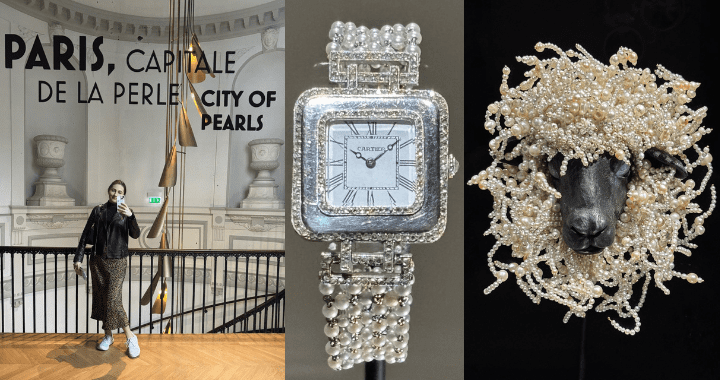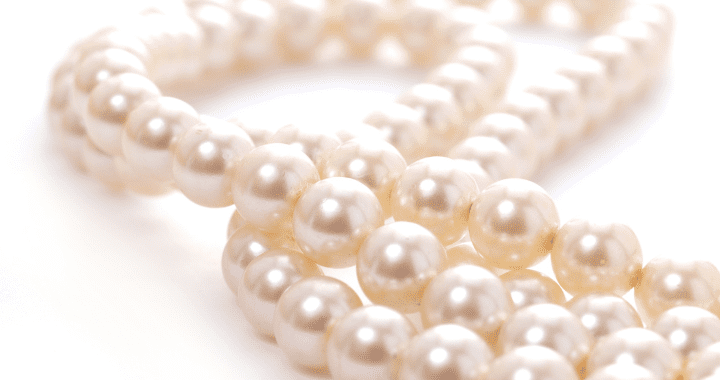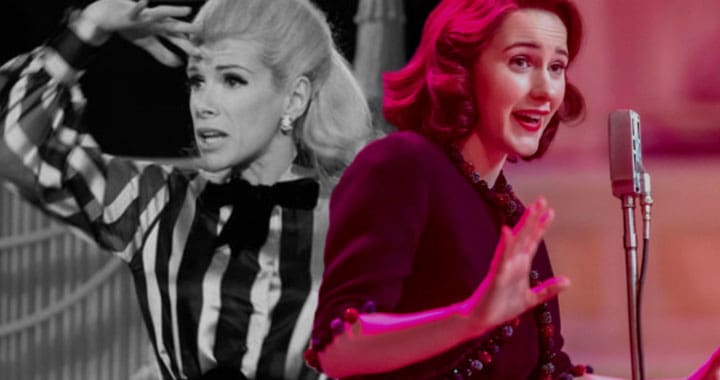Last month, jewellery specialist Liz Bailey visited the ‘Paris – City of Pearls’ Exhibition hosted by Van Cleef & Arpels L’Ecole School of Jewellery Arts. Held at the Hôtel de Mercy-Argenteau, nestled in a busy Parisian boulevard, VCA’s L’Ecole hosts regular lectures and exhibitions. Running until June of this year is this wonderful exhibition, documenting Paris’ unique position as the undisputed European ‘City of Pearls.’

Featuring pieces from France’s Third Republic onwards, the exhibition traces the exciting period from the late 1860s when many pearls found their way to the most prestigious jewellers in Paris on the Place Vendome and Rue de la Paix from the Arab and Persian Gulf. These great jewellers avidly sought out the finest pearls to adorn the aristocratic elite.

Examples from the French Art Nouveau are also on display from Vever, Fouquet and Lalique. These pieces differed drastically from their Belle Epoque contemporaries that opted for small, uniform pink pearls from the Gulf. These creative pieces instead displayed the beautiful free forms of baroque and Mississippi pearls, with these designers frequently favouring their unusual shapes and colours, as well as their comparable availability! A personal highlight was this stunning corsage ornament dating to circa 1900 by Henry Vever, designed as a wonderful sprawling flower, the petals in the form of Mississippi pearls with diamond centres and stems, and breathtaking plique-a-jour enamel foliage.

During the height of ‘pearl-mania’ in the early 20th century, Cartier was certainly one of the jewellers that created the most exquisite pieces, in jewellery and even watches. This exhibition displayed two beautiful Cartier bracelet watches, each with platinum cases and set with natural pearls to the crown, lugs and bracelet. It was in America however that the value of pearls reached its highest point, and in 1917 Jacques’ brother Pierre notoriously acquired his mansion on New York’s Fifth Avenue, acquired in exchange for a double strand pearl necklace.


The 1920s saw the Parisian fashion for pearls extend across the media, with these biogenic gems everywhere, from opera to cinema, literature posters and magazines. The International Exhibition of Modern Decorative and Industrial Arts showcased some of the most spectacular designs of the time and was the impetus for some breathtaking Art Deco pearl jewellery. Whilst the fresh arrival of the cultured pearl from Japan was a part of the public consciousness at this time, “for a while the demand for the natural pearl continued to increase,” only weakened by the economic crisis of 1929 and further with World War II.



Post-war pieces in the exhibition included both cultured and natural pearl pieces, representative of the growth in popularity of cultured pearl jewellery from this point onwards, with many Parisian merchants such as the Rosenthals even moving to Tahiti to reorient their business around the region’s black pearls. Strict trading agreements and initiatives are in place between France and the Gulf region to ensure the sustainability and success of the pearl.

Contemporary pieces on display include the iconic JAR sheep’s head clip, created by the infamously mysterious Parisian jeweller in 2006, and sold at Christies Paris in 2021 for €500,000. Another breathtaking jewel was a the ‘Cadeau Imperial’, a natural pearl, mystery-set ruby and diamond multi strand collar necklace, dating to 2011.

From the sky-high value of pearls during the early 20th century ‘pearl-mania,’ to the post-war cooling of prices and influx of cultured pearls onto the market, the values of pearls, as with any commodity, are subject to rise and fall. In the last year, we have seen a strengthening in prices for designer cultured pearl pieces, and a continued buoyancy for natural pearl pieces. To ensure your pearls are adequately covered, contact our team today for a specialist valuation.
L’Ecole School of Jewellery Arts was founded in 2012 with support from Van Cleef & Arpels, with schools in Paris, Hong Kong, Shanghai, Dubai and other locations. Created to make jewellery accessible to all and running a fantastic array of exhibitions, courses, podcasts and programmes, L’Ecole is certainly an organisation to be on any jewellery enthusiast’s radar! Paris City of Pearls will run until June of this year.


























